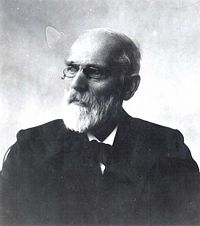PHZ3400 Phase Transition: Difference between revisions
Jump to navigation
Jump to search
MatthewHoza (talk | contribs) |
MatthewHoza (talk | contribs) |
||
| Line 12: | Line 12: | ||
[[Image:Johannes_Diderik_van_der_Waals.jpg|thumb|right|200px|Johannes Diderik van der Waals]] | [[Image:Johannes_Diderik_van_der_Waals.jpg|thumb|right|200px|Johannes Diderik van der Waals]] | ||
<math>P = \frac{T}{\nu b} - \frac{a}{\nu^2},\!</math> where <math>\nu \equiv \frac{N}{V}\!</math> | <math>P = \frac{T}{\nu b} - \frac{a}{\nu^2},\!</math> where <math>\nu \equiv \frac{N}{V}\!</math> | ||
<math>P</math> is | |||
<math>T</math> is | <math>P</math> is pressure | ||
<math>T</math> is temperature | |||
<math>N</math> is the number of particles | <math>N</math> is the number of particles | ||
<math>V</math> is volume | <math>V</math> is volume | ||
<math>a</math> and <math>b</math> are constants dependent on the material | |||
Revision as of 14:19, 27 January 2009
Phases of Matter
Matter can exist in many phases. The phases most common are solids, liquids, and gases. In Physics, a phase can be described as a region of space in which all physical properties of a material remain constant, or uniform. Having consistent physical properties and chemical uniformity allow one to distinguish between the various phases, or states of matter.
Gas-Liquid-Solid Phase Diagram
Phase Separation and Nucleation
This we'll cover on Friday, Jan. 30
Why Ice Floats? Consequences.
Van der Walls Equation
where
is pressure
is temperature
is the number of particles
is volume
and are constants dependent on the material








